What’s new in Botrytis control research?
New fungicides, environmental control and sanitation can limit disease.
The fungus Botrytis cinerea infects many greenhouse ornamentals. Recognizing Botrytis disease isn’t difficult. Common symptoms include leaf spots and blight, and stem cankers (Photo 1). Botrytis’ signature calling card includes the production of large masses of gray conidia or spores (“seeds” of the Botrytis pathogen). It is this gray conidial fuzz that gives this disease the common name of gray mold. These conidia are typically carried on air currents to nearby healthy plants where new infections can become established.
An infection that starts as a small leaf spot can quickly expand into a large area of dead plant tissue. Flower petals that drop onto the leaves provide a nutrient source and an entry point for Botrytis (Photo 1). A wounded or cut stem is especially vulnerable to Botrytis attack. Stock plants become wounded when cuttings are taken and then Botrytis can infect at the wound site with disease progressing downward causing dieback. Botrytis typically becomes established and reproduces on older lower leaves that are near the moist soil surface and under the plant canopy. Botrytis can also infect and reproduce on dead plant tissue in the pot or on the greenhouse bench or floor, which can be a source of future infections.
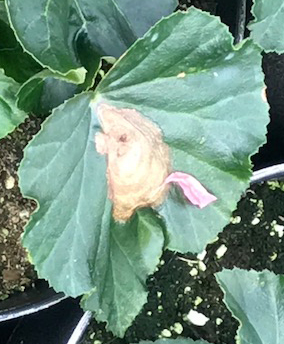
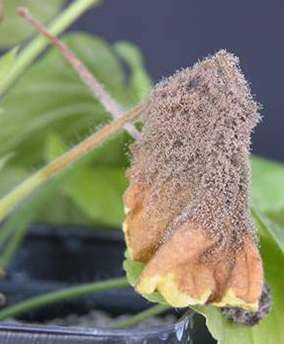
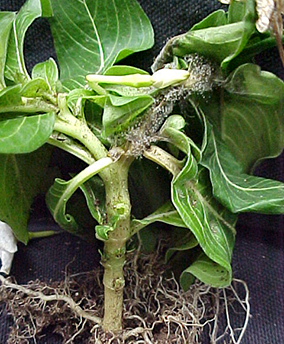
Photo 1. Botrytis infection on ornamental crops. Left/top, spot on begonia started by a dropped flower petal. Middle, Botrytis with spores on a geranium leaf. Right/bottom, Botrytis stem and leaf infection on vinca. All photos by Mary Hausbeck, MSU.
Water on the leaf or flower surface allows the Botrytis conidia to germinate and penetrate the plant. A moist and humid environment favors Botrytis infection, and includes the wetting of plants due to dew, condensation or water dripping from overhead lines. Cuttings propagated under mist should be scouted daily for signs of Botrytis infection. Also, check if the frequency or duration of misting can be reduced and still maintain the rooting efficiency.
Minimize Botrytis at the finishing stage by watering at a time of the day when the foliage can dry rapidly. Space plants further apart and provide good air circulation to keep relative humidity as low as possible. When relative humidity reaches 85 percent or higher, the risk of a Botrytis outbreak becomes high. Reduce the relative humidity for a minimum of 24 hours immediately following the harvesting of cuttings to help dry the wounded stems and thereby limit Botrytis stem blight.
Scout for Botrytis disease by looking for the brown/gray fuzziness on lower leaves that signals the need for control measures. Sanitation is always important and reduces Botrytis and other disease problems. Remove dead leaves, flowers and plants from greenhouse benches and floors to prevent Botrytis using discarded plant material as a way to become established and spread to healthy plants.
Once the plant becomes infected with Botrytis, it becomes more difficult to limit the damage. Fungicides can be an effective tool against Botrytis in the greenhouse and there are several products to choose from. Our Michigan State University floriculture disease program carries out research trials each year on the diseases affecting floriculture crops and the products that can provide protection. Industry standards that have been proven to work and have been used by greenhouse growers for many years include Daconil WeatherStik, Decree DF and Chipco 26019. The newer biopesticide product, Affirm WDG, has proven to be effective in several of our studies.
Newly-registered fungicides including Pageant Intrinsic 38WG, Orkestra (Photo 2), Insignia WG and Palladium WDG are also good choices based on MSU disease research studies and could be included in an effective Botrytis control program. Some of these products are grouped together based on their FRAC code, which indicates they operate against Botrytis in a similar way. To ensure the Botrytis pathogen does not become resistant to fungicides, use a spray program that includes several types of fungicides that have different FRAC codes.
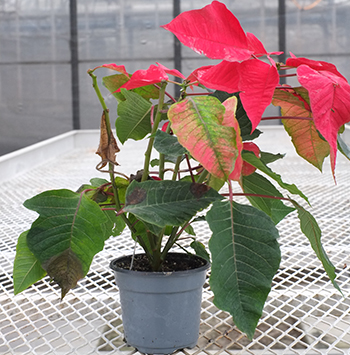
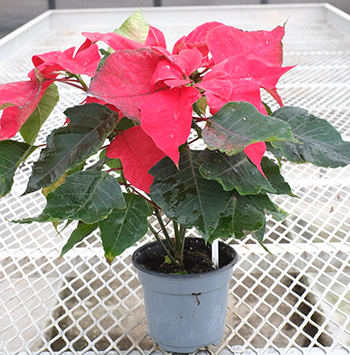
Photo 2. Left/top, untreated poinsettia showing severe Botrytis infection. Right/bottom, the Orkestra-treated plant remained mostly disease free. All photos by Mary Hausbeck, MSU.
The A and B Team table shows the results of many years of testing fungicide products and lists the product name, FRAC code and active ingredient. The products listed in the A Team are especially effective against Botrytis. The B Team products also limit disease, but may not be as effective as the A Team products and are recommended for use when disease pressure is not severe and for use in alternating programs. Always alternate among fungicide products with active ingredients that have different modes of action (FRAC codes) to delay the development of fungicide resistance in the Botrytis pathogen.
|
Botrytis A Team | ||
|---|---|---|
|
Product |
FRAC* |
Active ingredient |
|
Affirm WDG |
19 |
polyoxin D zinc salt |
|
Daconil Weatherstik SC |
M5 |
chlorothalonil |
|
Decree 50DF |
17 |
fenhexamid |
|
Chipco 26019 |
2 |
iprodione |
|
Pageant Intrinsic 38WG |
11/7 |
pyraclostrobin/boscalid |
*The FRAC code is an alphanumeric code assigned by the Fungicide Resistance Action Committee and is based on the mode of action of the active ingredient.
|
Botrytis B Team* | ||
|---|---|---|
|
Product |
FRAC** |
Active ingredient |
|
Compass O WDG |
11 |
trifloxystrobin |
|
Heritage WDG |
11 |
azoxystrobin |
|
Insignia WG |
11 |
pyraclostrobin |
|
Orkestra |
7/11 |
fluxapyroxad/pyraclostrobin |
|
Palladium WDG |
9/12 |
cyprodinil/fludioxonil |
*Not recommended when disease pressure is high.
**The FRAC code is an alphanumeric code assigned by the Fungicide Resistance Action Committee and is based on the mode of action of the active ingredient.
Acknowledgement. This research was supported by funding from the Floriculture Nursery and Research Initiative of the Agricultural Research Service under Agreement #58-8062-5-036.



 Print
Print Email
Email



